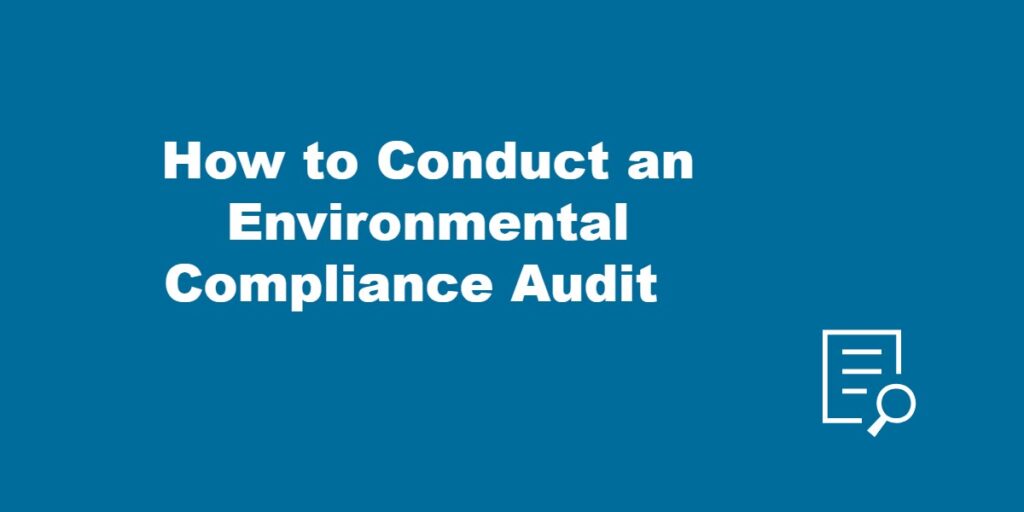The growing concerns about climate change have put the spotlight on companies and their actions towards the environment. Governments and the public are closely watching both the positive and negative impacts of every action. To better evaluate and understand this impact, an environmental compliance audit is necessary. Besides providing information to the public and governments, these audits are also a way for organizations to understand if they are meeting the prevailing environmental laws and regulations.
In this guide, we will discuss how you can plan, conduct, and evaluate the results of an environmental compliance audit. As a bonus, we will also provide a handy checklist to ease this process.
What is an Environmental Compliance Audit?
As the name suggests, an environmental compliance audit assesses the actions and practices of an organization and its compliance with applicable environmental regulations. It identifies the gaps, so the organization can take corrective action to address them.
This audit is done by external auditors who check against specific laws like the U.S. EPA audit guidelines. Also, they do a comprehensive ESG compliance audit when needed.
While the exact environmental compliance review process varies between organizations, it must include the following.
- Reviewing permits and licenses to ensure they are still valid.
- Checking records related to actions like emissions, water management, and waste disposal.
- Evaluating the energy consumption and its sources.
- Inspecting physical locations for the presence of pollution control systems, water treatment, etc., and assessing their performance.
- Interviewing staff to understand their level of awareness and the training given to them.
- Analyzing the efficacy of emergency response plans.
- Assessing the availability of documentation and their quality and comprehensiveness.
Including the above aspects in an environmental audit can ensure compliance with existing ESG standards. It will also reduce fines and improve the performance of organizations.
Why it Matters: Risks & Regulations
Environmental compliance goes beyond just audits. It is a reflection of an organization’s commitment to preserving the environment and is an integral part of corporate social responsibility.
A well-executed environmental compliance audit allows companies to detect and fix problems before they are picked up by regulators and the public, saving them from fines and reputational loss.
Here’s a look at the risks that come from not conducting an environmental compliance audit.
Legal Risks
The most obvious fallout is the legal risks from non-compliance with prevailing environmental regulations. This can lead to financial fines and penalties, costly cleanup mandates, criminal charges for willful neglect, increased scrutiny and frequent inspections, and even a temporary or permanent shutdown of operations. Besides these losses, companies will also have to spend millions in legal fees to fight against these rulings.
To avoid the above consequences, it’s important to understand the relevant regulations and adhere to their guidelines. Some common regulations are:
| Legislation | Coverage | Non-compliance Consequences |
|---|---|---|
| Clean Air Act (CAA) | Limits the amount of pollutants released into the air. | Fines + mandatory installation of control technologies and systems. |
| Clean Water Act (CWA) | Regulates wastewater discharges into surface water. | Fines + loss of permits. |
| Resource Conservation and Recovery Act (RCRA) | Focuses on how hazardous waste is collected, treated, and disposed of. | Severe legal consequences, including criminal charges and temporary and permanent shutdown of operations. |
| Emergency Planning and Community Right-to-Know Act (EPCRA) | Mandates the reporting of how hazardous substances are stored and handled on-site. | Fines + civil legal suits. |
| Toxic Substances Control Act (TSCA) | Regulates all the chemicals and their handling not covered by other U.S. federal statutes. | Fines + restricted market access. |
Financial and Operational Risks
Besides lawsuits and fines, non-compliance can also impact operations and, through it, lead to financial loss. A few likely consequences of non-compliance are:
- Higher insurance premiums.
- Delayed projects.
- Higher employee attrition.
- Shrinking market.
- Poor public perception.
Stakeholder Risks
Reputation is a key benchmark that can attract stakeholders. When investors, employees, and customers have a positive perception about your organization, they will be ready to invest and buy from you. On the other hand, a negative perception, especially non-compliance with environmental laws, can cause them to move away. This reputational loss can have serious consequences for business continuity.
An ESG compliance audit that includes an environmental review can help your organization assess its current practices and identify gaps in compliance. Accordingly, you can take the necessary actions to prevent the above-mentioned risks.
Pre-Audit Preparation
A successful audit starts with a detailed plan and preparation, as these aspects speed up the audit and make it more relevant for your organization. Before getting started with the environmental compliance audit, let’s look at some important areas of focus.
Define the Scope
The first aspect is to define the scope of the audit. Do you want to conduct an audit across the entire organization, or do you want to limit it to a specific facility/department? Similarly, what areas should the audit focus on? Are there specific compliance laws you want to target?
Answers to these questions will help define the scope and objectives of an audit, so it is highly targeted and successful.
Review Regulations
After defining the scope, list out all the regulations that you want to follow. This list can include the mandatory laws in your country as well as the voluntary standards with which you want to comply to boost your reputation and credibility. While creating this list, take into account your internal policies, budgets, and sustainability commitment levels as well.
Collect and Organize Documentation
Before the auditors start the process, collect and organize the necessary documents for their evaluation. Similarly, provide access to the required materials and inform your employees what to expect. Some likely documents that auditors will need are:
- Permits and licenses (air, water, waste)
- Spill response and emergency plans
- Waste manifests and disposal records
- Emissions monitoring data
- Chemical inventories
- Training logs
- Equipment maintenance records
- Internal inspection reports
Assemble the Audit Team
If you’re hiring external auditors, make sure you also have an internal team that can assist them. Your team can include an environmental manager or coordinator, the facility manager, and a legal or compliance officer. Additionally, you can also have someone record the proceedings and document the same.
Pre-audit Walkthrough
Before the audit begins, do a quick walkthrough of the facility and address the obvious problems. Some areas to look for are improperly labeled containers, lack of signage, blocked emergency exits, and outdated documentation.
With these steps, you are all set for the audit.
How to Conduct the Audit
With the pre-audit preparations in place, you can now start the audit process. During the entire audit, never lose sight of the goal and the scope, and assess the existing state of operations against the established objectives.
The broad steps involved in an environmental compliance audit are:
Kickoff Meeting
Start with a kickoff meeting, where you apprise everyone of the audit’s objectives and the process. Make the necessary introductions between the internal team members and the external auditors, and assign clear responsibilities for each employee. Make sure you have the necessary communication channels and review the schedule, so everyone is on the same page.
Facility Inspections
Many auditors prefer to start with a walkthrough of the physical space to identify the obvious irregularities. Some likely focus areas are:
- Checking vents and controlling equipment for air emissions.
- Inspecting wastewater treatment facilities, sampling logs, stormwater controls, and other aspects related to water discharges.
- Reviewing the containers and the handling processes of hazardous waste materials.
- Verifying the storage methods and safety measures for chemical substances stored on-site.
- Evaluating the presence of emergency exits and their access, availability of fire quadrants, and other safety protocols.
- Analyzing documents and existing signage.
While doing audits, make sure to take photos and videos that can serve as evidence.
Review Documentation
After the physical inspections, sit down to thoroughly review the available documentation. Specifically, look for the following.
- Expired permits or licenses.
- Incomplete logs.
- Missing records of hazardous waste disposal.
- Gaps in employee training or certifications.
- Inconsistencies between physical conditions and reported data.
More importantly, compare the actual practices with the documentation to check if they are in alignment.
Conduct Interviews
Depending on your findings and the goals of your audit, conduct interviews of employees. Before talking to them, make a list of questions you want to ask. These can revolve around the level of training and knowledge they have in environmental actions, how they handle waste, emergency response procedures, maintenance, and anything else pertinent to the audit.
When possible, take the consent of the employees and record the conversation. If it is an audio recording, record their consent at the beginning of the conversation, and state the objectives of this interview. If you are documenting it, take their signature, as these measures will provide legal coverage and can act as evidence.
Identify Issues
After collecting information from different sources, take time to analyze it and identify the prevailing issues. Accordingly, classify them into high-risk, medium-risk, and low-risk, so organizations can allocate resources accordingly. Based on your findings, create a comprehensive report.
Conduct a Closing Meeting
At the end of the review, conduct a closing meeting where you thank all the participants and provide an overview of your findings. You can also discuss the next steps and provide a timeline for the final report. Remember, transparency is the key to building trust.
With these steps, you have successfully completed an audit.
Post-Audit Steps & Reporting
The real value of an environmental compliance audit lies in its post-audit activities. After identifying the gaps/issues, record and prioritize them to help the organization take corrective action. Provide as much information as possible.
An important responsibility of the post-audit is to create a detailed report. In this report, provide a clear breakdown of the findings along with evidence. Also, provide a list of recommended actions that an organization can take to address these issues. If possible, provide a way for measuring and tracking the corrective actions. Such detailed information adds a ton of value to the organization and can help meet the compliance requirements.
Lastly, share the findings with the leadership team and offer follow-up reviews, suggest appropriate training programs, and make the necessary suggestions.
Free Downloadable Checklist
Below is a detailed checklist to verify if your facility meets the environmental regulations.
1. General Environmental Permits
- Air emissions permits are current and available.
- Wastewater discharge permits are up-to-date.
- Stormwater permits are available and accurate.
- Hazardous waste generator ID is registered.
- Permits cover all facility operations and emission points.
- Annual or quarterly reports submitted on time.
2. Air Emissions
- Emission sources are properly labeled.
- Control equipment is inspected and maintained.
- Stack test results are documented.
- Daily/weekly/monthly air emissions logs are complete.
- Deviations or exceedances are reported and resolved.
- Backup power systems comply with air regulations.
3. Water Discharges
- Wastewater treatment systems are functioning properly.
- Sampling and testing records are complete and current.
- Outfall locations match permit requirements.
- Oil/water separators are cleaned and maintained.
- Stormwater outfalls are cleaned and inspected regularly.
- Spill prevention plans are in place.
4. Hazardous Waste Management
- Waste containers are labeled with content and accumulation date.
- Storage time limits are not exceeded.
- Incompatible wastes are properly segregated.
- Satellite accumulation areas are compliant.
- Manifests and shipping records are complete.
- Waste is disposed of using licensed transporters.
- The hazardous waste contingency plan is on file and updated.
5. Chemical Storage
- Chemicals are stored with secondary containment.
- Safety Data Sheets (SDS) are available for all chemicals.
- Storage areas are ventilated and secured.
- Incompatible materials are stored separately.
- Inventory of all chemicals is current.
- Expired or unused chemicals are removed regularly.
6. Spill Response and Emergency Preparedness
- Spill kits are stocked and accessible.
- Emergency contact information is posted.
- Employees know how to report spills.
- Spill drills are conducted annually.
- An emergency response plan is reviewed yearly.
- Fire extinguishers and alarms are maintained.
7. Training and Documentation
- Employees handling hazardous materials are trained.
- Training records are maintained and up to date.
- New hires receive environmental compliance training.
- Annual refresher training is completed.
- Written SOPs exist for waste handling and emissions control.
- Environmental compliance policies are reviewed annually.
8. Inspections and Monitoring
- Routine internal inspections are conducted.
- Inspection logs are signed and dated.
- Monitoring equipment, like pH meters and flow meters, is calibrated at the required levels.
- Non-compliance events are investigated and documented.
- Preventive maintenance schedules are followed.
9. Records and Reporting
- All required environmental reports are submitted on time.
- Records are kept for at least 3–5 years as required.
- Permit files are complete and accessible.
- Inspection and enforcement correspondence is documented.
- A compliance calendar is used to track deadlines.
10. Site-Specific Considerations
- Asbestos, PCBs, or lead-based paint issues are addressed.
- Above-ground and underground storage tanks are registered and inspected.
- Refrigerants are handled as per EPA regulations.
- Endangered species or wetlands on-site are managed responsibly.
- Local and state-specific regulations are included in audits.
11. ESG and Sustainability
- Energy use is tracked and optimized.
- Waste reduction/recycling programs are active.
- ESG goals are defined and reported.
- GHG emissions are measured and disclosed.
- ESG audit records are maintained for investors or customers.
Bonus Tip: Link this checklist with your internal audit software or compliance tracker. For software recommendations, see PlanetCompliance’s Best Tools for ESG Compliance.
Tools & Software
Using the right tools can speed up the environmental compliance audit and make it more accurate and relevant for your organization. They are also more streamlined when compared to manual audits, which are likely to miss items or hold inconsistent data. Also, using software platforms can help track compliance obligations and ensure that your organization meets the relevant standards.
Environmental Management Systems (EMS) also allow companies to schedule inspections, store the required documents, upload audit reports, create action items, and track their completion. It is a single interface through which an organization can meet its environmental obligations. Its centralized dashboards and integration with monitoring and control devices provide comprehensive visibility into your current state of operations.
For companies that have ESG reporting requirements, opt for ESG platforms, as they come with features like emissions tracking, stakeholder reporting, and more.
If you’re looking for a comprehensive platform that can take care of environmental compliance audit requirements, here’s a list of useful tools.
Final Thoughts
To conclude, environmental compliance audits provide a ton of benefits for organizations. They go beyond just meeting the regulatory requirements, as they provide credibility and trust to the organization. However, the audit must be conducted in a certain way for it to be effective. In this article, we have laid down the pre- and post-audit processes, along with a comprehensive step-by-step guide on how to conduct an audit.
Download our free Environmental Compliance Audit checklist to stay on top of audits and meet the regulatory requirements.


